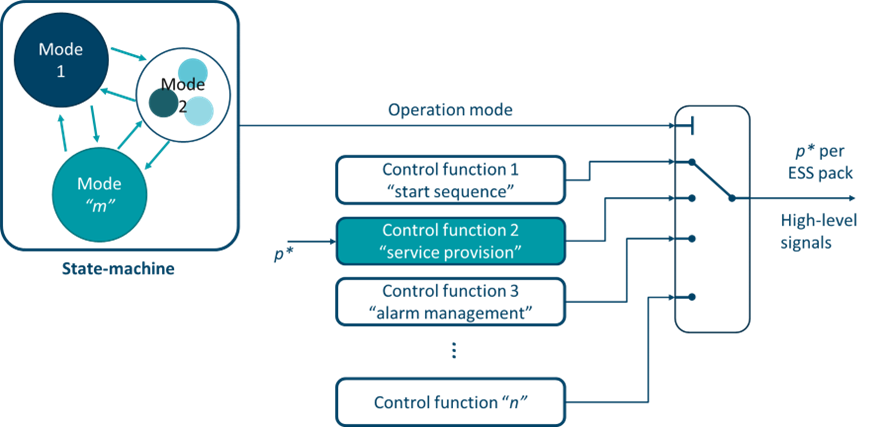Result from partners MGEP, AIT, EDF and coordinator VUB.
The result has been achieved on 31 March 2022 in month 16 of the project (results documented in Work Package 4: Universal self-healing energy management strategy).
Based on the specifications and requirements defined in Work Package 1 and the hybrid energy storage system (HESS) structure proposed with the co-design optimization framework in Work Package 2, Milestone 11 has been achieved with the development of a new high-level EMS algorithm in the framework of Work Package 4. This solution has consisted of an overarching state-machine and various control functionalities to operate the HESS at different Use cases.
The objective of the developed EMS has been the internal management of power between the high-energy (HE) and high-power (HP) battery packs to provide the grid-services requested by the application. For this purpose, a general state-machine has been designed and combined with specific control functions to initialize, operate and stop the HESS in case of failure (see the Figure below).
In the state-machine, a hardware and software commissioning protocol and a connection sequence have been defined to connect the HESS to the grid. An alarm mode of operation has been also defined to handle faults and to activate the protection systems when necessary. Other modes include the stopping and normal operation.
For the achievement of this milestone, special attention has been paid to the development of control functions to dynamically allocate the overall power setpoint between the HE and HP battery packs. The aim has been to propose an interoperable EMS structure that could be easily adapted to provide various grid services. Three different use cases have been considered, namely a Pan-European grid, an EV charging station and a microgrid. The grid services consist of an enhanced frequency response for Use case 1, a maximum power and ramp rate limitation for Use case 2, and a fast frequency response and daily shifting service for Use case 3.
The individual control functions as well as the complete standard EMS algorithm have been tested in simulation to check the correctness of the state-machine, the transitions between different modes of operation and an adequate operation of the control algorithms developed for the three use cases.
The Milestone 11 was achieved with the submission of report 4.1 (confidential, public summary available here), which contained the details about the state-machine operation modes, their transition conditions, and the features of the proposed EMS functionalities to provide the grid services mentioned above.
The proposed interoperable EMS will be further examined in the framework of Task 4.1, and the results obtained up to this point will be used as a basis for the self-healing algorithms in Task 4.2 and the upscaling solutions in Task 4.4.
